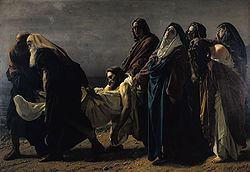- Antonio Ciseri
-
Antonio Ciseri (b. Ronco sopra Ascona, Switzerland, 25 October 1821; d. Florence, 8 March 1891) was an Italian[1][2] painter of religious subjects.
He went to Florence in 1833 to study drawing with Ernesto Bonaiuti, and from 1834 he was a pupil of Niccola and Pietro Benvenuti at the Accademia di Belle Arti; he was later taught by Giuseppe Bezzuoli, who greatly influenced the early part of his career. In 1849, he began offering instruction to young painters, and eventually ran a private art school. Among his earliest students was Silvestro Lega.[3]
Ciseri's religious paintings are Raphaelesque in their compositional outlines and their polished surfaces, but are nearly photographic in effect. He fulfilled many important commissions from churches in Italy and Switzerland. Ciseri also painted a significant number of portraits. He died in Florence on March 8, 1891.
Notes
- ^ "Antonio Ciseri." Oxford Grove Art. Web. 26 Apr. 2011.
- ^ "Ciseri, Antonio." Treccani, il portale del sapere. Web. 26 Apr. 2011. (Italian)
- ^ Ciseri, Spalleti, & Sisi 1991, p. 164.
References
- Ciseri, A., Spalletti, E., & Sisi, C. (1991). Omaggio ad Antonio Ciseri, 1821-1891: dipinti e disegni delle gallerie fiorentine : Firenze, Galleria d'arte moderna di Palazzo Pitti, 28 settembre-31 dicembre 1991. Firenze: Centro Di. ISBN 88-7038-213-3 (Italian language)
- Antonio Ciseri in the SIKART dictionary and database
- Art Gallery of Hamilton
Categories:- Italian painter stubs
- 1821 births
- 1891 deaths
- Italian painters
- People from Ticino
Wikimedia Foundation. 2010.


